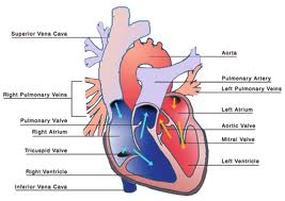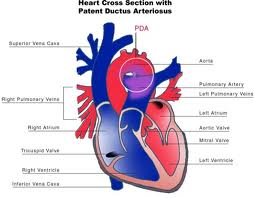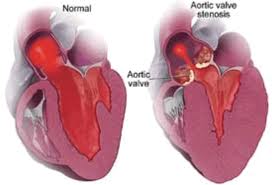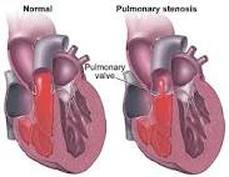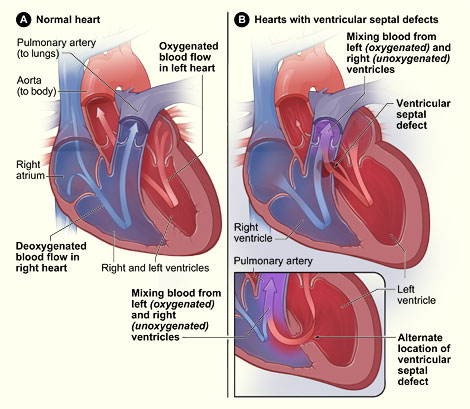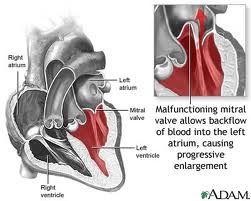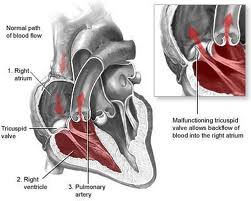Heart Conditions
The common heart diseases in Amstaffs are as follows:
Patent ductus arteriosus (PDA):
The problem is the failure of the ductus arteriosis to close shortly after birth and thereby allows continued flow of blood between the aorta and pulmonary artery. This was originally though to be the most frequently encountered congenital cardiac defect in all dogs. It is now believed by cardiologist that aortic stenosis is the most common.
Usually this condition presents itself at 6 to 12 weeks of age and is more common in females. Signs of heart failure are usually absent. Often a prominent pulse may be noted in many unusual areas on the body (ie.gums). A continuous murmur is present.
Prognosis: Treatment for PDA is via surgical correction or coil occlusion. In the hands of a skilled surgeon the survival rate is 90%. Without surgery, it is estimated, though not substantiated, that 60% will die by 1 year.
The problem is the failure of the ductus arteriosis to close shortly after birth and thereby allows continued flow of blood between the aorta and pulmonary artery. This was originally though to be the most frequently encountered congenital cardiac defect in all dogs. It is now believed by cardiologist that aortic stenosis is the most common.
Usually this condition presents itself at 6 to 12 weeks of age and is more common in females. Signs of heart failure are usually absent. Often a prominent pulse may be noted in many unusual areas on the body (ie.gums). A continuous murmur is present.
Prognosis: Treatment for PDA is via surgical correction or coil occlusion. In the hands of a skilled surgeon the survival rate is 90%. Without surgery, it is estimated, though not substantiated, that 60% will die by 1 year.
Aortic Stenosis (AS):
AS is the most common congenital cardiac defect and most difficult to diagnose in the dog. The stenotic lesion may occur in the subvalvular position, valvular position or supravalvular position. The subvalvular is the most common in dogs.
This has been documented in many breeds, including Bull Terriers. It should be noted this is the most common condition that causes the exploding hearts in Amstaffs. The genetic factor(s) of AS are not known as of yet. It is believed to be polygenetic, and therefore very difficult to eliminate from the gene pool. Only through the testing of all breeding stock and strict culling of positive animals and producers of positive animals are there hopes to eventually eliminate this condition.
AS can be present at birth or develop up to one year of age. It has not been documented to develop in dogs over 1 year. It can be present as adults with an incidental murmur. Signs of heart failure are rare. Dysrhythmias with pulse deficits may be noted. Systolic heart murmur is located over left heart base and radiates of the neck and to the right hemothorax.
Definitive diagnosis can be done via Doppler echocardiography or Cardiac catheterization. EKG will show normal and diagnosis for AS is inconclusive. A presumptive diagnosis can be done via ausculation of a left systolic heart murmur with a weak femoral arterial pulse.
Treatment includes beta blockers (though they are controversial) or very limited surgical options. Though heart failure is rare, it is more likely to occur in cases of moderate and severe AS if concurrent mitral valve insufficiency is present and severe.
Prognosis:
· Most cases of AS of marked severity result in sudden death.
· Mild cases of AS live a full life (both normal quality and duration)
· Even cases of moderate stenosis can anticipate a life of normal length and quality.
· Work with Doppler echocardiography has revealed that if the velocity of flow across the left ventricular outflow is less than 4 m/s by the time the dog is mature, it appears that the dogs can anticipate a life of normal length and quality. If the velocity is greater than 5 m/s it will likely succumb to this disorder.
· Progression of AS is very slow in mature dogs.
· It has been reported that if dogs survive with AS beyond 3 years, they usually do not have AS severe enough to produce a marked effect on left valve performance.
AS is the most common congenital cardiac defect and most difficult to diagnose in the dog. The stenotic lesion may occur in the subvalvular position, valvular position or supravalvular position. The subvalvular is the most common in dogs.
This has been documented in many breeds, including Bull Terriers. It should be noted this is the most common condition that causes the exploding hearts in Amstaffs. The genetic factor(s) of AS are not known as of yet. It is believed to be polygenetic, and therefore very difficult to eliminate from the gene pool. Only through the testing of all breeding stock and strict culling of positive animals and producers of positive animals are there hopes to eventually eliminate this condition.
AS can be present at birth or develop up to one year of age. It has not been documented to develop in dogs over 1 year. It can be present as adults with an incidental murmur. Signs of heart failure are rare. Dysrhythmias with pulse deficits may be noted. Systolic heart murmur is located over left heart base and radiates of the neck and to the right hemothorax.
Definitive diagnosis can be done via Doppler echocardiography or Cardiac catheterization. EKG will show normal and diagnosis for AS is inconclusive. A presumptive diagnosis can be done via ausculation of a left systolic heart murmur with a weak femoral arterial pulse.
Treatment includes beta blockers (though they are controversial) or very limited surgical options. Though heart failure is rare, it is more likely to occur in cases of moderate and severe AS if concurrent mitral valve insufficiency is present and severe.
Prognosis:
· Most cases of AS of marked severity result in sudden death.
· Mild cases of AS live a full life (both normal quality and duration)
· Even cases of moderate stenosis can anticipate a life of normal length and quality.
· Work with Doppler echocardiography has revealed that if the velocity of flow across the left ventricular outflow is less than 4 m/s by the time the dog is mature, it appears that the dogs can anticipate a life of normal length and quality. If the velocity is greater than 5 m/s it will likely succumb to this disorder.
· Progression of AS is very slow in mature dogs.
· It has been reported that if dogs survive with AS beyond 3 years, they usually do not have AS severe enough to produce a marked effect on left valve performance.
Pulmonary Stenosis (PS):
PS is the third most prevalent cardiac disorder in the dog. A stenotic lesion may occur in subvalvular, valvular or supravalvular position. The valvular disorder is the most common in dogs. Symptoms include fatigue and exercise intolerance. A definitive diagnosis for PS is via the Doppler echocardiography or Cardiac catherization test. EKG provides insight into the disorder. A presumptive diagnosis can be made via ausculation of a left basilar systolic heart murmur with a normal femoral arterial pulse. Dilation of the main pulmonary artery on thoracic radiographs may be seen.
The treatment of choice for severe PS is surgical correction. However the efficacy of surgical intervention remains to be substantiated. Medication to control dysrhythmias and fluid around the heart may also be an option.
Prognosis: Mild cases can be expected to live a full life with this abnormality. Severe cases of PS may die suddenly or develop signs of right heart failure and die in 6-12 months.
PS is the third most prevalent cardiac disorder in the dog. A stenotic lesion may occur in subvalvular, valvular or supravalvular position. The valvular disorder is the most common in dogs. Symptoms include fatigue and exercise intolerance. A definitive diagnosis for PS is via the Doppler echocardiography or Cardiac catherization test. EKG provides insight into the disorder. A presumptive diagnosis can be made via ausculation of a left basilar systolic heart murmur with a normal femoral arterial pulse. Dilation of the main pulmonary artery on thoracic radiographs may be seen.
The treatment of choice for severe PS is surgical correction. However the efficacy of surgical intervention remains to be substantiated. Medication to control dysrhythmias and fluid around the heart may also be an option.
Prognosis: Mild cases can be expected to live a full life with this abnormality. Severe cases of PS may die suddenly or develop signs of right heart failure and die in 6-12 months.
Ventricular Septal Defect (VSD):
This abnormality is a defect allowing blood flow between the left and right ventricle. This defect usually presents itself in puppies. A large defect will stunt growth and the pup will fail to thrive.
A definitive diagnostic test for VSD is via Doppler or Cardiac catheterization. A presumptive diagnosis can be made by ausculation of a right sternal border systolic heart murmur or radiographic evidence of pulmonary overcirculation.
Symptoms include reduced exercise tolerance, fatigue, possible heart murmur and jugular distention.
Treatment for mild VSD requires no therapy, whereas severe VSD requires surgical repair. Prognosis for severe VSD if pulmonary hypertension develops is very poor.
This abnormality is a defect allowing blood flow between the left and right ventricle. This defect usually presents itself in puppies. A large defect will stunt growth and the pup will fail to thrive.
A definitive diagnostic test for VSD is via Doppler or Cardiac catheterization. A presumptive diagnosis can be made by ausculation of a right sternal border systolic heart murmur or radiographic evidence of pulmonary overcirculation.
Symptoms include reduced exercise tolerance, fatigue, possible heart murmur and jugular distention.
Treatment for mild VSD requires no therapy, whereas severe VSD requires surgical repair. Prognosis for severe VSD if pulmonary hypertension develops is very poor.
Mitral Valve Dysplasia (MVD):
The most common disorder of the mitral valve is the partial backflow (regurgitation) of blood through the valve. Regurgitation is usually the result of valvular degeneration, which occurs most often in older members of the smaller dog breeds. Severe mitral regurgitation, not only produces significant increases in the left side of the heart, it is frequently accompanied by varying degrees of congestive heart failure.
The most common disorder of the mitral valve is the partial backflow (regurgitation) of blood through the valve. Regurgitation is usually the result of valvular degeneration, which occurs most often in older members of the smaller dog breeds. Severe mitral regurgitation, not only produces significant increases in the left side of the heart, it is frequently accompanied by varying degrees of congestive heart failure.
Tricuspid Valve Dysplasia (TVD):
This valve is located between the right atrium and the right ventricle of the heart. The purpose of this valve is to control the backflow of blood during contractions of the heart.
During normal fetal development, the tricuspid valve flaps are adhered to the wall separating atrium from ventricle. As the fetal development progresses under normal circumstances the adhesive bonds holding the valve open will degenerate, allowing the valve flaps to move into their proper position.
One of the primary causes of TVD is the failure of the bond to degenerate. Depending on the severity of the malformation, the work on the right side of the heart increases.
Symptoms of TVD are dependent upon the extent of the malformation, but some of the most common symptoms re: fluid retention, cool extremities and exercise intolerance (possibly followed by collapse).
TVD in dogs is usually congenital (present at birth). Due to the fact that this condition (when it occurs) appears in several littermates, and tends to be more prevalent in some family bloodlines than others, it is suspected that the tendency to have this birth defect is hereditary. It is hoped that through screening of breeding stock and their lineage (parents, grandparents, littermates, aunts, uncles, etc) efforts can be made to eliminate susceptible bloodlines from breeding programs.
This valve is located between the right atrium and the right ventricle of the heart. The purpose of this valve is to control the backflow of blood during contractions of the heart.
During normal fetal development, the tricuspid valve flaps are adhered to the wall separating atrium from ventricle. As the fetal development progresses under normal circumstances the adhesive bonds holding the valve open will degenerate, allowing the valve flaps to move into their proper position.
One of the primary causes of TVD is the failure of the bond to degenerate. Depending on the severity of the malformation, the work on the right side of the heart increases.
Symptoms of TVD are dependent upon the extent of the malformation, but some of the most common symptoms re: fluid retention, cool extremities and exercise intolerance (possibly followed by collapse).
TVD in dogs is usually congenital (present at birth). Due to the fact that this condition (when it occurs) appears in several littermates, and tends to be more prevalent in some family bloodlines than others, it is suspected that the tendency to have this birth defect is hereditary. It is hoped that through screening of breeding stock and their lineage (parents, grandparents, littermates, aunts, uncles, etc) efforts can be made to eliminate susceptible bloodlines from breeding programs.
